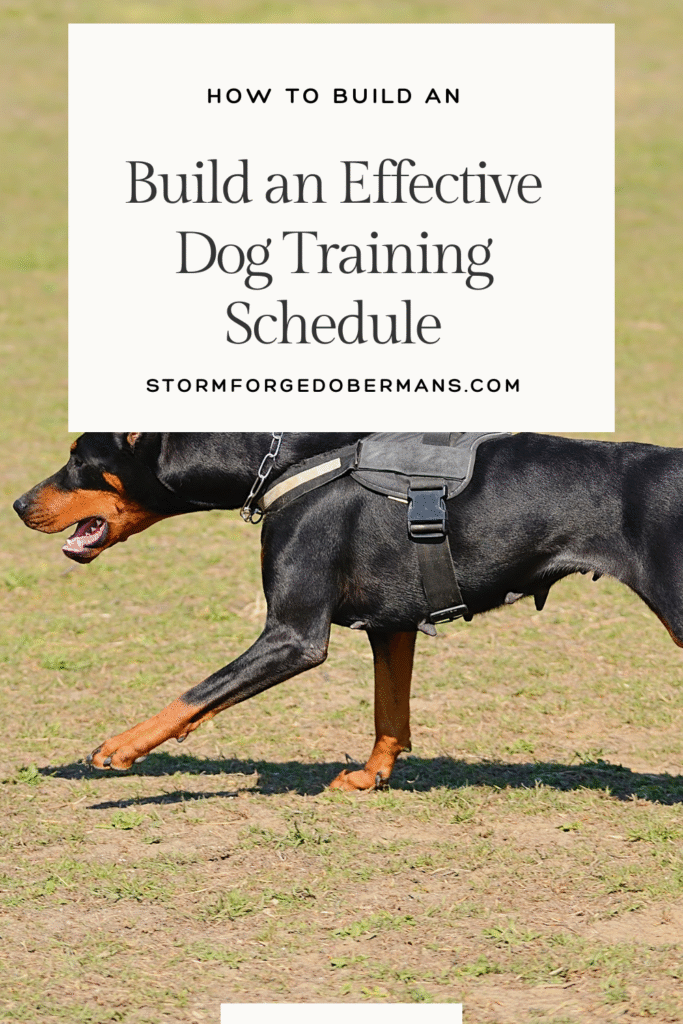Creating a consistent dog training schedule is one of the most powerful ways to build trust, structure, and results with your dog—whether you’re working with a puppy or an adult. An effective training schedule helps set clear goals, ensures regular practice, and promotes overall obedience and behavior improvement.
A dog training schedule isn’t about cramming sessions in—it’s about thoughtful, consistent engagement. By following a structured dog training schedule, you help your dog know what to expect and when.
Here’s a step-by-step guide to building a training schedule that works for you and your dog.
Why a Dog Training Schedule Matters
A consistent dog training schedule is one of the most powerful tools you have as a handler or dog owner. Dogs thrive on structure and predictability—knowing what to expect reduces anxiety, improves focus, and builds trust between you and your dog.
When training happens at random times or is inconsistent in tone and length, dogs can become confused or disengaged. On the other hand, a regular dog training schedule reinforces routines, sharpens skills faster, and helps your dog approach each session with confidence and clarity.
For working breeds like Dobermans, a structured training schedule is especially important. These dogs have high drive and intelligence, which can quickly spiral into frustration or unwanted behaviors if their energy isn’t properly channeled.
By following a daily or weekly dog training schedule, you’re not only building obedience—you’re also creating emotional stability, improving your dog’s engagement, and shaping them into a reliable partner whether you’re working in obedience, protection, or everyday life.
1. Define Your Training Goals
Before you start creating a schedule, determine what you want to achieve with your dog’s training. Your dog training schedule doesn’t have to be rigid—it just needs to be consistent. Your goals might include:
- Basic Obedience: Commands like sit, stay, and come.
- Behavioral Improvement: Addressing issues like barking, jumping, or chewing.
- Advanced Skills: Agility, tricks, or specialized tasks.
- Socialisation: Getting your dog comfortable with various environments, people, and other animals.
Clear goals will guide the structure of your training schedule and help you measure progress. The best dog training schedule is one you can stick to over time.
2. Assess Your Dog’s Needs
Consider your dog’s age, breed, and energy level when planning training sessions. Training will look different for each dog depending on their age, maturity, and goals—we’re often working with dogs at different stages of development. Depending on your dog’s age, drive, and current abilities, you may want to break up your day into short sessions—mental stimulation is just as important as physical exercise. For example:
- Puppies: Short, frequent sessions with lots of play.
- Adult Dogs: Longer, focused sessions with a mix of challenges.
- Senior Dogs: Gentle, shorter sessions with low-impact activities.
Tailor your schedule to fit your dog’s needs for optimal results. We follow a flexible but effective dog training schedule with all our working Dobermans.
3. Choose Training Methods
Select training methods that align with your goals and your dog’s learning style. Common methods include:
- Positive Reinforcement: Rewarding desired behaviors with treats, praise, or toys.
- Clicker Training: Using a clicker to mark and reinforce specific behaviors.
- Lure and Reward: Using a treat or toy to guide your dog through commands or tricks.
Consistency in methods helps your dog understand and retain commands better.
4. Plan Your Training Sessions
Decide on the frequency and duration of training sessions based on your goals and your dog’s attention span. High drive dogs often need more structure to avoid burnout—balancing intensity and rest is crucial. A balanced schedule might look like:
- Frequency: Aim for 2-3 short sessions per day or 4-5 sessions per week.
- Duration: Keep sessions brief, around 5-15 minutes, to maintain your dog’s focus and enthusiasm.
Include time for both training and play to keep your dog engaged and happy.
5. Create a Training Calendar
Design a visual calendar to keep track of your training schedule. You can use a physical planner, a digital calendar, or a dedicated training app. Mark your training sessions, track progress, and make adjustments as needed. Especially for puppies and young working dogs, the importance of routine can’t be overstated
Consider including:
- Training Days: Specific days and times for each session.
- Breaks: Regular days off to allow for rest and prevent burnout.
- Goals and Milestones: Notes on what you aim to achieve in each session.
6. Incorporate Variety
Keep training sessions interesting by incorporating variety. Rotate through different commands, tricks, and environments to prevent boredom and encourage learning. Especially for puppies and young working dogs, the importance of routine can’t be overstated.
Part of building an effective dog training schedule is understanding your dog’s energy levels and planning training when your dog is most focused. You can also include gear training in your routine—muzzle desensitization or harness work can easily be added to short sessions. For example:
- Different Locations: Practice commands in various settings, like the park or around the house.
- Varied Commands: Mix basic commands with new tricks or agility exercises.
- Interactive Toys: Use different toys and rewards to maintain enthusiasm.
7. Monitor Progress
Regularly assess your dog’s progress and adjust the training schedule as needed. If your dog is struggling with a concept, take a break and use play as part of the training process before trying again. Monitor:
- Behavioral Changes: Note improvements and areas needing more focus.
- Engagement Levels: Watch for signs of boredom or frustration and modify sessions accordingly.
- Health and Well-being: Ensure that training activities are suitable for your dog’s physical condition.
8. Seek Professional Guidance
If you encounter challenges or need additional support, consider seeking help from a professional dog trainer. They can provide tailored advice, address specific issues, and enhance your training approach.
9. Maintain Consistency and Patience
Consistency is key in dog training. Stick to your schedule as closely as possible, and be patient with your dog’s progress. Training takes time, and positive reinforcement helps build trust and confidence. No matter your dog’s age or experience, a consistent training routine allows you to make steady progress and start with a strong foundation.
10. Tips for Sticking to Your Dog Training Schedule
Consistency is key when following a dog training schedule. Setting realistic goals and sticking to specific times each day can help you and your dog build a routine that lasts. Even on busy days, short but focused sessions are better than skipping training altogether.
Using reminders or calendar alerts can keep you accountable, ensuring your dog receives consistent guidance. Remember, a dog training schedule isn’t about perfection — it’s about steady progress that fits into your lifestyle and keeps your dog mentally engaged.
11. Common Mistakes in Dog Training Schedules and How to Avoid Them
Many dog owners struggle with maintaining an effective dog training schedule because they either overtrain or undertrain their dogs. Overloading sessions can lead to burnout and frustration, while inconsistent training can confuse your dog and slow progress.
Another common mistake is failing to adjust the schedule as your dog matures or their needs change. Avoid these pitfalls by planning balanced, varied sessions and reviewing your dog training schedule regularly to ensure it meets your dog’s evolving abilities and energy levels.
Building an effective training schedule is a crucial step in achieving success with your dog’s training. By setting clear goals, assessing your dog’s needs, and maintaining consistency, you can create a structured plan that fosters positive behavior and strengthens your bond with your furry companion.
Ready to build a dog training schedule that works for you and your Doberman? Start small, stay consistent, and watch your dog’s skills and confidence grow every day. Have questions or tips from your own experience? Drop a comment below — I’d love to hear how your training routine is going!

